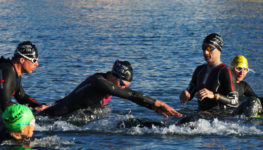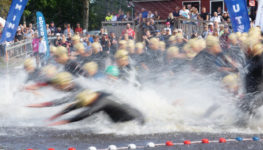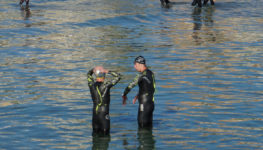ARE YOU LOSING SIGHT OF YOUR SWIM?
How easy is it to swim straight? This is a question most of us need to ask ourselves, especially if racing in open water.
Almost everyone has an asymmetrical swim stroke and there are many potential reasons, such as limb length, mobility, strength, technique or coordination. These discrepancies often translate to misalignment, tracking issues and, worst case scenario, injury. Asymmetry is not necessarily an issue but can result in a change in direction when swimming!
The Pro’s and Con’s of Pools
Most of our swim training hours are spent in a pool. Pools are great for developing fitness, strength and technique and they are often more convenient. Pools, however, are rectangular and linear in design (most of the time!) with tiles, lane ropes, walls and floor markings; all these features have a soul purpose – to keep us organised and controlled, and so can help keep alignment.
This is good! Being organised and controlled prevents accidents and utilises space efficiently. However, we get so used to swimming in these conditions, our brains and bodies learn to use these straight visual cues to correct mechanical imbalances, technique and misalignment.
Now move into an open water environment, where there are no tiles, no floor markings, no lane ropes or walls, but there is current, wind and swell…
Sense of Direction
Without visual cues, the brain has no way of auto-correcting, it is amazing how quickly a swimmer can go off course! On our camps, we test everyone’s alignment by getting each athlete to swim 30 strokes with their eyes close in the sea. Almost everyone goes off course, and occasionally see swimmers turn 180° within those 30 arm strokes.
This same assessment can be tested in a pool too – in an empty lane (with lane ropes either side, not a wall), swim a length counting your strokes then swim a second length swimming 3-4 strokes less, but with your eyes closed! See what happens?
Basically, asymmetry is unavoidable, not necessarily wrong, and can take months or even years to correct – time better spent training. Therefore, learning and practicing sighting will help keep you swimming straight in open water, despite any asymmetry.
Swim the Distance
 If you intend to swim Ironman distance, 3.8km, then that is what you want to swim, not 4km+! Sighting, the most important open water skill, will keep you tracking true and can be practiced every time you swim – even in the pool.
If you intend to swim Ironman distance, 3.8km, then that is what you want to swim, not 4km+! Sighting, the most important open water skill, will keep you tracking true and can be practiced every time you swim – even in the pool.
To sight in swimming, a simple elevation of the head before, after or instead of turning to breathe is needed to sight a buoy or object. Elevation should be as necessary (less is best, though); calm conditions requires little lift of the head to see, whereas choppier conditions require bigger lifts – sometimes looking like water polo swimmers.
 It is also worth noting that rather than pausing to sight, you should try to glance in the general direction of the object you are looking for and then “process” the glance when your head is back in the water. This will help to keep speed, rhythm and alignment while reducing drag.
It is also worth noting that rather than pausing to sight, you should try to glance in the general direction of the object you are looking for and then “process” the glance when your head is back in the water. This will help to keep speed, rhythm and alignment while reducing drag.
Practice
Start incorporating sighting into your sessions! To start with, slot it into your warm ups and / or cool down (to get used to it without the pressure of hitting your times), then, when you are comfortable add it to your main sets.



